
I’ve been thinking about the “best” way to help students use cognitive science (3 box model/cognitive load model) to make decisions about how they study. There’s great advice out there for students about how to study:
- this is my favorite article, I think
- Stephen Chew’s how to study videos are fantastic
- the Crash Course videos are really good
BUT in my (limited) experience so far, many students aren’t “convinced” by these kinds of organized presentations of research-based advice. What would convince them?
Here’s one thought (and I haven’t tried it yet): if students could make a their own personalized model of memory, could they use that customized model to make small changes in their behavior? I’ve been sharing a lesson plan called “Sketch Your Memory” with teachers and so far teachers say they find it useful, but I don’t know if students will respond to it.
I wonder if we help students get some background knowledge about the 3 box memory model/cognitive load theory, would it be helpful if they then go on to make their own graphic of the model? The graphic might include some of the basic terminology from the background knowledge, AND students customize their model with examples (maybe in a different color?) of actions they already take or could take to “enact” that part of the model.
Example: after a student fills in “deep processing” as a term related to encoding (in the encoding arrow between working and long term memory), they could fill in their plan for deep processing (“For every vocab term I have to learn, I’ll write in a quick example from my life that relates to the vocab word.”)
I’d love to hear your thoughts: would a personalized 3 box memory model like this help students motivate themselves to change their studying?